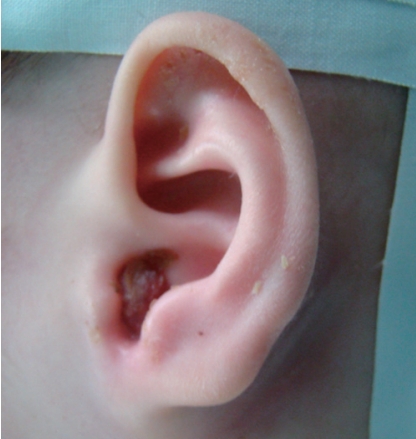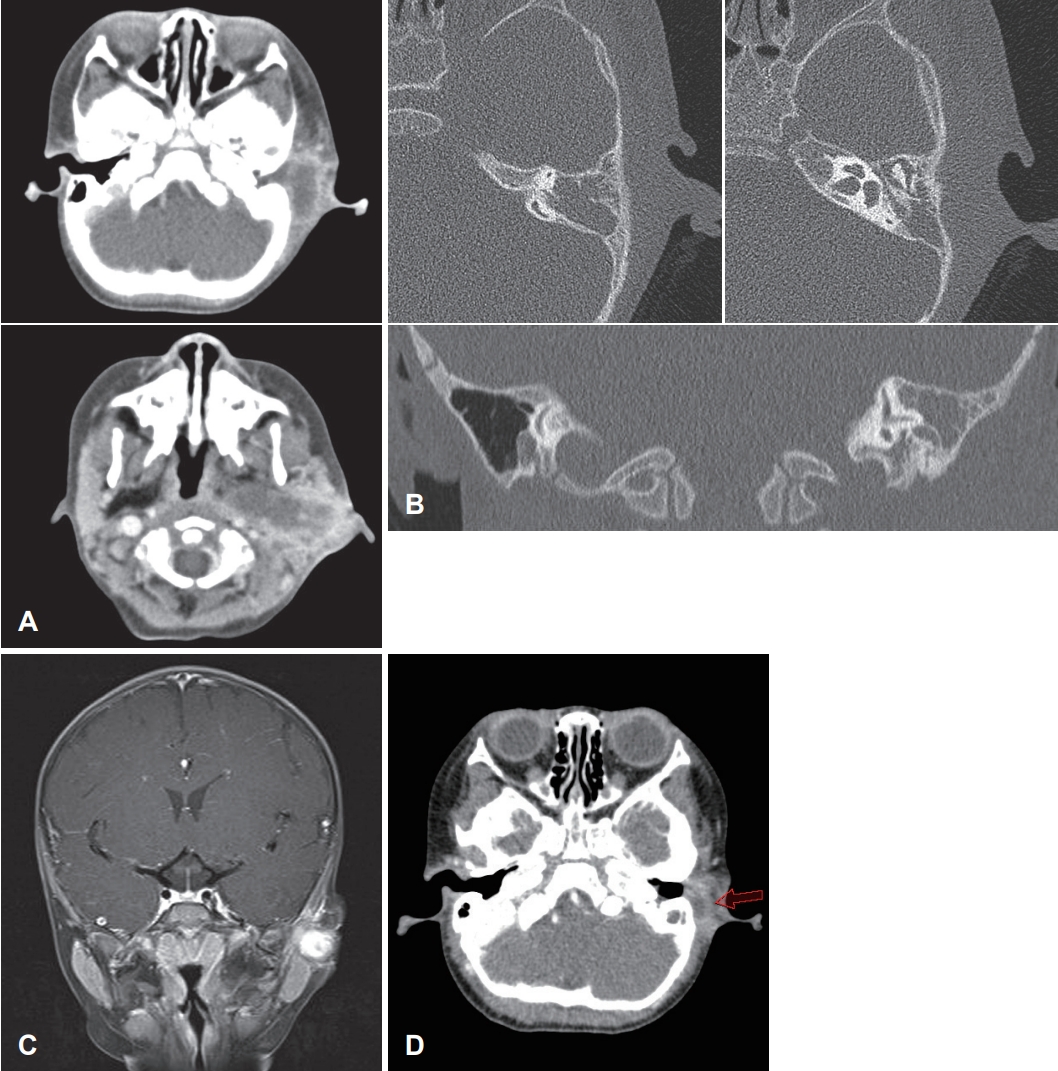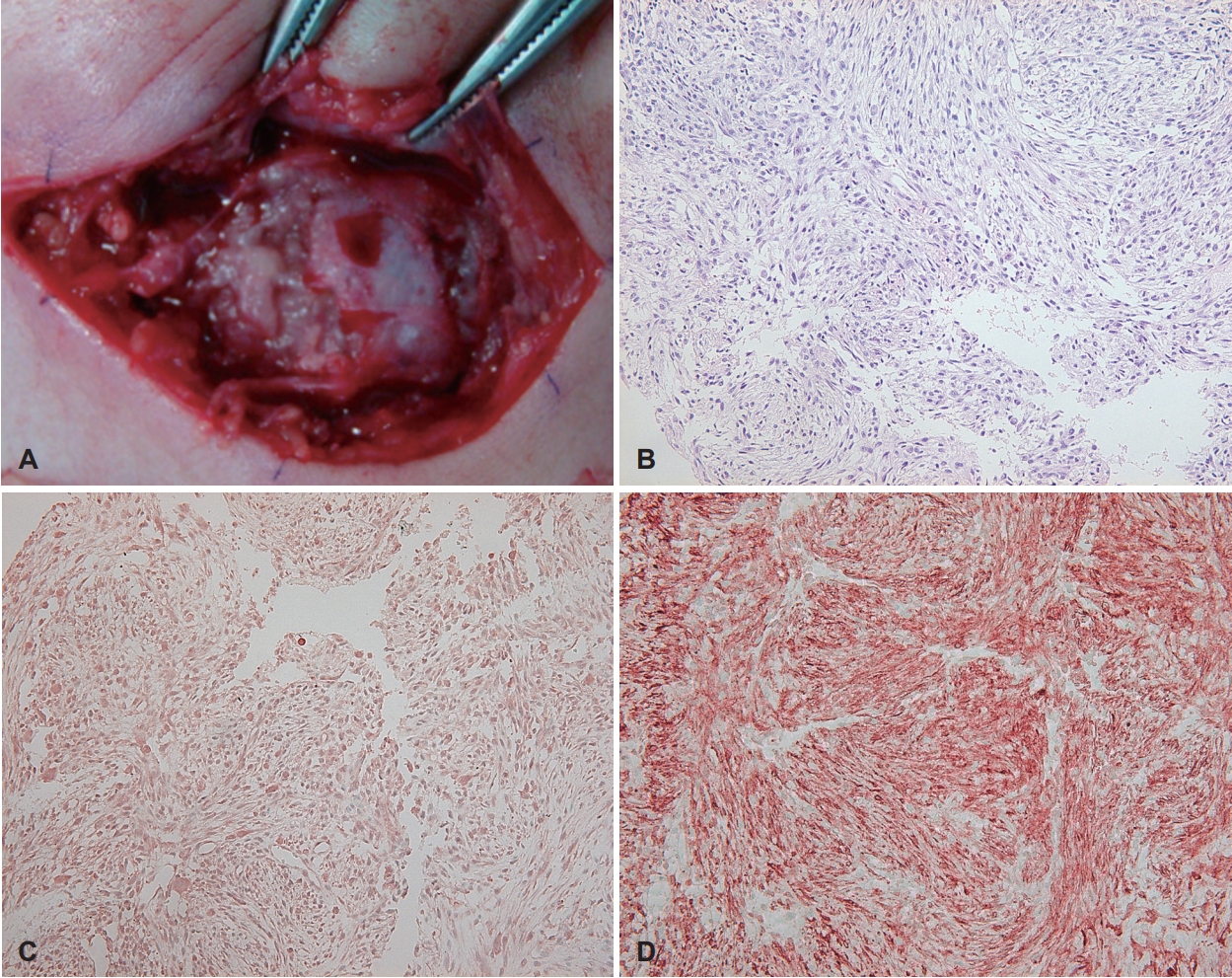 |
 |
AbstractRhabdomyomas are rare benign tumors. Most extracardiac rhabdomyomas are found in the head and neck region, especially in the pharynx and larynx. Herein, we have described the case of a 1-year-old boy presenting with recurrent otorrhea and postauricular swelling. His symptoms were due to a mass that was histologically diagnosed as fetal rhabdomyoma (FR). Here, we report the first case of FR in the postauricular area. Clinicians should keep in mind the possibility of FR if a child presents with external auditory canal mass associated with recurrent otorrhea and signs of mastoiditis.
IntroductionFetal rhabdomyomas (FRs) are extremely rare benign tumors that originate from skeletal muscles. These tumors usually appear in neonates, and most of them are of the cardiac type. Extracardiac FRs are generally found in the head and neck, especially the aerodigestive tract. Among the pediatric population, approximately 7 cases of postauricular FR have been reported to date; however, none have manifested as acute mastoiditis [1-3].
CaseAn otherwise healthy 1-year-old boy was referred to our department for purulent otorrhea from his left ear that had occurred 2 weeks ago (Fig. 1). He received antibiotic therapy for 2 weeks at a local clinic; however, there was no evidence of improvement. Methicillin-resistant staphylococcus aureus was found in a bacterial culture of the otorrhea. Physical examination revealed a red-colored easy-bleeding mass in the distal external auditory canal. Because of the mass, the eardrum could not be identified. Injection and swelling were also observed in the postauricular area. There was no palpable mass on the other sites of the body.
Contrast-enhanced temporal bone CT revealed a swelling with rim-enhancing fluid collection in the left temporal area. The lesion extended to the left external auditory canal and parapharyngeal space. The ipsilateral mastoid was filled with soft tissue. Coronal T2-weighted MRI demonstrated a mass-like lesion with high signal intensity in the postauricular area extending to the left external auditory canal (Fig. 2).
The mass-like lesion was initially suspected to be an epidermal cyst, hemangioma, or pyogenic granuloma and was the reason for acute mastoiditis. At 1 month, elective surgery was performed. After the posterior auricular flap was elevated, a round, red-colored mass was noted. The fistula communicating with the inferior external auditory canal and left tonsillar fossa was also discovered. The mass was excised. Surgical resection could not be complete due to severe inflammation.
Histologically, the mass comprised bundles and fascicles of spindle cells within the myxoid stroma. Diffuse expression of myoglobin and cytoplasmic expression of smooth muscle actin were found in immunochemical studies. The specimen, however, was negative for S-100 protein and desmin. This result corresponded to that of FR (Fig. 3).
Two weeks later, the patient visited our outpatient clinic. Symptoms of otorrhea, postauricular swelling, and infection disappeared. Postoperative complications, such as facial palsy, did not occur. Two months following surgery, contrast-ehnanced CT revealed a 12 mm diameter lesion with rim-enhancing fluid collection on the posterior wall of the external auditory canal (Fig. 2). However, no recurrence was observed during the 3-year follow-up period.
DiscussionAcute mastoiditis is an inflammatory process of the mastoid cells and is related to the destruction of the mastoid. Although the frequency of acute mastoiditis has decreased significantly since the development of antibiotics, it is still commonly found in the pediatric population. Acute mastoiditis can develop when the treatment for acute otitis media (AOM) fails. Acute mastoiditis is diagnosed when otoscopy reveals signs of AOM (e.g., redness and bulging of the tympanic membrane) and local mastoid inflammation is prominent (e.g., pain, injection, tenderness, and auricular swelling), or when mastoid inflammatory changes coexist with mastoiditis on radiography or surgery, with or without signs of AOM.
Rhabdomyomas are rare, benign, striated muscle tumors. These are divided into two groups: cardiac and extracardiac. The cardiac type, which occurs predominantly in the hearts of infants and children, is more common than the extracardiac type and is associated with tuberous sclerosis. The head and neck area, especially the pharynx and larynx, account for 70%-90% of extracardiac rhabdomyomas [4]. Extracardiac rhabdomyomas are histopathologically subdivided into adult, fetal, and genital types. The fetal type is the rarest form. In contrast to rhabdomyosarcoma, which has infiltrated margins, FRs are well-circumscribed and localized superficially [5]. Treatment of FRs involves local excision, and the recurrence rate is very low.
We reviewed the literature on FRs of the head and neck area in the pediatric population by searching PubMed. The adult population and other types of rhabdomyomas were excluded. Twenty case reports have been published. Among these, the postauricular area was the most involved site (7 cases), followed by the tongue (3 cases). Almost all the chief complaints were an asymptomatic mass (16 cases), followed by a local swelling (2 cases) and eye-related symptoms (2 cases) due to its location and proximity. After local excision, recurrence did not usually occur, except in one case report by Konrad, et al. [6]. There was a male predominance of 3:1 (Table 1).
FRs generally occur in the mucosa or soft tissues [1]. FRs present with symptoms depending on the anatomic location: an asymptomatic mass or localized swelling. If FRs in the soft tissue grew significantly, it could distort the normal anatomy of the adjacent tissues and structures. Finally, various clinical symptoms can also be observed. This case report highlights a case of acute mastoiditis not resulting from recurrent AOM but from a postauricular mass and FR. Herein, FR was seen in the postauricular area of a 1-year-old boy, extending to the external auditory canal, causing multiple symptoms of erythema, swelling, and otorrhea, as seen in acute mastoiditis. After surgery, all symptoms had disappeared, and no recurrence was observed for 3 years. There are a series of case reports on postauricular FR in children in the previous literature. However, to the best of our knowledge, this is the first case report of FR associated with acute mastoiditis.
In conclusion, to date, there has been no literature in which FR in the postauricular region presented as acute mastoiditis. Therefore, we reported this unusual case with a short literature review. In addition, we recommend that if a child with external auditory canal mass associated with recurrent otorrhea and signs of mastotiditis (postauricular swelling, injection, or pain) comes to the clinic, clinicians should consider the possibility of FR.
Fig.┬Ā1.A red-colored easy-bleeding mass in the auditory canal and injection in the postauricular area. 
Fig.┬Ā2.CT and MRI images of a 1-year-old boy who presented with left purulent otorrhea. A: Axial contrast-enhanced CT demonstraing a swelling in the left postauricular area and external auditory canal, which extended to the parapharyngeal space. B: Axial and coronal CT demonstating left mastoid filled with soft tissue density. C: Coronal T2-weighted MRI demonstrating a left postauricular mass extending to the external auditory canal. D: Posteoperative axial contrast-enhanced CT demonstraing a 12 mm diameter lesion with rim-enhancing fluid collection on the posterior wall of the external auditory canal (arrow). 
Fig.┬Ā3.Gross and microscopic tissue images of the left postauricular mass. A: The postauricular mass in operation field. B: Tumor cells were characterized by bundles and fascicles of spindle cells within myxoid stroma (hematoxylin & eosin stain, ├Ś200). C: Tumor cells were positive for myoglobin on immunostaining (myoglobin immunostain, ├Ś200). D: Tumor cells were positive for smooth muscle actin on immunostaining (smooth muscle actin immunostain, ├Ś200). 
Table┬Ā1.Characteristics of the head and neck fetal rhabdomyomas presenting under the age of eighteen
REFERENCES1. Kapadia SB, Meis JM, Frisman DM, Ellis GL, Heffner DK. Fetal rhabdomyoma of the head and neck: A clinicopathologic and immunophenotypic study of 24 cases. Hum Pathol 1993;24(7):754-65.
2. Walsh SN, Hurt MA. Cutaneous fetal rhabdomyoma: A case report and historical review of the literature. Am J Surg Pathol 2008;32(3):485-91.
3. Leboulanger N, Picard A, Roger G, Garabedian EN. Fetal rhabdomyoma of the infratemporal fossa in children. Eur Ann Otorhinolaryngol Head Neck Dis 2010;127(1):30-2.
4. Carron JD, Darrow DH, Karakla DW. Fetal rhabdomyoma of the posterior cervical triangle. Int J Pediatr Otorhinolaryngol 2001;61(1):77-81.
5. Fern├Īndez JM, Medlich MA, L├│pez LH, Loredo CF, Luque LC. Fetal intermediate rhabdomyoma of the lip: Case report. J Clin Pediatr Dent 2005;29(2):179-80.
6. Konrad EA, Meister P, H├╝bner G. Extracardiac rhabdomyoma: Report of different types with light microscopic and ultrastructural studies. Cancer 1982;49(5):898-907.
7. Dehner LP, Enzinger FM, Font RL. Fetal rhabdomyoma. An analysis of nine cases. Cancer 1972;30(1):160-6.
8. Fu YS, Perzin KH. Nonepithelial tumors of the nasal cavity, paranasal sinuses, and nasopharynx: A clinicopathologic study. IV. Smooth muscle tumors (leiomyoma, leiomyosarcoma). Cancer 1975;35(5):1300-8.
9. Simha M, Doctor V, Dalal S, Manghani DK, Dastur DK. Postauricular fetal rhabdomyoma: Light and electron microscopic study. Hum Pathol 1982;13(7):673-7.
10. Bozic C. Fetal rhabdomyoma of the parotid gland in an infant: Histological, immunohistochemical, and ultrastructural features. Pediatr Pathol 1986;6(2-3):139-44.
11. Eusebi V, Ceccarelli C, Daniele E, Collina G, Viale G, Mancini AM. Extracardiac rhabdomyoma: An immunocytochemical study and review of the literature. Appl Pathol 1988;6(3):197-207.
12. al Rikabi AC, al Kharfy T, al Sohaibani MO, al Samarrai AI. Fetal rhabdomyoma. A case report with the diagnosis suggested by intraoperative cytology. Acta Cytol 1996;40(4):786-8.
13. P├®rez-Alonso P, S├Īnchez-Sim├│n R, Contreras F, Patr├│n-Romero M. Special feature: Pathological case of the month. Denouement and discussion: Fetal rhabdomyoma of the tongue (myxoid type). Arch Pediatr Adolesc Med 2000;154(12):1265-6.
|
|
||||||||||||||||||||||||||||||||||||||||||||||||||||||||||||||||||||||||||||||||||||||||||||||||||||||||||||||||||||||||||||||||||||||||||||||||||||||||||||||||||||||||||||||||||||||||||

 |
 |